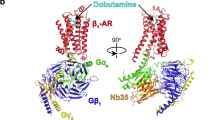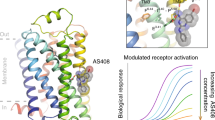Abstract
Adenosine receptors and β-adrenoceptors are G-protein-coupled receptors (GPCRs) that activate intracellular G proteins on binding the agonists adenosine1 or noradrenaline2, respectively. GPCRs have similar structures consisting of seven transmembrane helices that contain well-conserved sequence motifs, indicating that they are probably activated by a common mechanism3,4. Recent structures of β-adrenoceptors highlight residues in transmembrane region 5 that initially bind specifically to agonists rather than to antagonists, indicating that these residues have an important role in agonist-induced activation of receptors5,6,7. Here we present two crystal structures of the thermostabilized human adenosine A2A receptor (A2AR-GL31) bound to its endogenous agonist adenosine and the synthetic agonist NECA. The structures represent an intermediate conformation between the inactive and active states, because they share all the features of GPCRs that are thought to be in a fully activated state, except that the cytoplasmic end of transmembrane helix 6 partially occludes the G-protein-binding site. The adenine substituent of the agonists binds in a similar fashion to the chemically related region of the inverse agonist ZM241385 (ref. 8). Both agonists contain a ribose group, not found in ZM241385, which extends deep into the ligand-binding pocket where it makes polar interactions with conserved residues in H7 (Ser 2777.42 and His 2787.43; superscripts refer to Ballesteros–Weinstein numbering9) and non-polar interactions with residues in H3. In contrast, the inverse agonist ZM241385 does not interact with any of these residues and comparison with the agonist-bound structures indicates that ZM241385 sterically prevents the conformational change in H5 and therefore it acts as an inverse agonist. Comparison of the agonist-bound structures of A2AR with the agonist-bound structures of β-adrenoceptors indicates that the contraction of the ligand-binding pocket caused by the inward motion of helices 3, 5 and 7 may be a common feature in the activation of all GPCRs.
This is a preview of subscription content, access via your institution
Access options
Subscribe to this journal
Receive 51 print issues and online access
$199.00 per year
only $3.90 per issue
Buy this article
- Purchase on Springer Link
- Instant access to full article PDF
Prices may be subject to local taxes which are calculated during checkout




Similar content being viewed by others
References
Fredholm, B. B. et al. International Union of Basic and Clinical Pharmacology. LXXXI. Nomenclature and classification of adenosine receptors—an update. Pharmacol. Rev. 63, 1–34 (2011)
Evans, B. A. et al. Ligand-directed signalling at β-adrenoceptors. Br. J. Pharmacol. 159, 1022–1038 (2010)
Hofmann, K. P. et al. A G protein-coupled receptor at work: the rhodopsin model. Trends Biochem. Sci. 34, 540–552 (2009)
Rosenbaum, D. M., Rasmussen, S. G. & Kobilka, B. K. The structure and function of G-protein-coupled receptors. Nature 459, 356–363 (2009)
Rasmussen, S. G. et al. Structure of a nanobody-stabilized active state of the β2 adrenoceptor. Nature 469, 175–180 (2011)
Rosenbaum, D. M. et al. Structure and function of an irreversible agonist–β2 adrenoceptor complex. Nature 469, 236–240 (2011)
Warne, T. et al. The structural basis for agonist and partial agonist action on a β1-adrenergic receptor. Nature 469, 241–244 (2011)
Jaakola, V. P. et al. The 2.6 Ångstrom crystal structure of a human A2A adenosine receptor bound to an antagonist. Science 322, 1211–1217 (2008)
Ballesteros, J. A. & Weinstein, H. Integrated methods for the construction of three dimensional models and computational probing of structure function relations in G protein-coupled receptors. Methods Neurosci. 25, 366–428 (1995)
Kobilka, B. K. & Deupi, X. Conformational complexity of G-protein-coupled receptors. Trends Pharmacol. Sci. 28, 397–406 (2007)
Yao, X. J. et al. The effect of ligand efficacy on the formation and stability of a GPCR-G protein complex. Proc. Natl Acad. Sci. USA 106, 9501–9506 (2009)
Vauquelin, G. & Van Liefde, I. G protein-coupled receptors: a count of 1001 conformations. Fundam. Clin. Pharmacol. 19, 45–56 (2005)
Palczewski, K. et al. Crystal structure of rhodopsin: a G protein-coupled receptor. Science 289, 739–745 (2000)
Li, J. et al. Structure of bovine rhodopsin in a trigonal crystal form. J. Mol. Biol. 343, 1409–1438 (2004)
Park, J. H. et al. Crystal structure of the ligand-free G-protein-coupled receptor opsin. Nature 454, 183–187 (2008)
Scheerer, P. et al. Crystal structure of opsin in its G-protein-interacting conformation. Nature 455, 497–502 (2008)
Cherezov, V. et al. High-resolution crystal structure of an engineered human β2-adrenergic G protein-coupled receptor. Science 318, 1258–1265 (2007)
Rasmussen, S. G. et al. Crystal structure of the human β2 adrenergic G-protein-coupled receptor. Nature 450, 383–387 (2007)
Warne, T. et al. Structure of a β1-adrenergic G-protein-coupled receptor. Nature 454, 486–491 (2008)
Wu, B. et al. Structures of the CXCR4 chemokine GPCR with small-molecule and cyclic peptide antagonists. Science 330, 1066–1071 (2010)
Chien, E. Y. et al. Structure of the human dopamine D3 receptor in complex with a D2/D3 selective antagonist. Science 330, 1091–1095 (2010)
Oldham, W. M. & Hamm, H. E. Heterotrimeric G protein activation by G-protein-coupled receptors. Nature Rev. Mol. Cell Biol. 9, 60–71 (2008)
Murphree, L. J. et al. Human A2A adenosine receptors: high-affinity agonist binding to receptor-G protein complexes containing Gβ4 . Mol. Pharmacol. 61, 455–462 (2002)
Serrano-Vega, M. J., Magnani, F., Shibata, Y. & Tate, C. G. Conformational thermostabilization of the β1-adrenergic receptor in a detergent-resistant form. Proc. Natl Acad. Sci. USA 105, 877–882 (2008)
Magnani, F., Shibata, Y., Serrano-Vega, M. J. & Tate, C. G. Co-evolving stability and conformational homogeneity of the human adenosine A2A receptor. Proc. Natl Acad. Sci. USA 105, 10744–10749 (2008)
Shibata, Y. et al. Thermostabilization of the neurotensin receptor NTS1. J. Mol. Biol. 390, 262–277 (2009)
Kim, S. K. et al. Modeling the adenosine receptors: comparison of the binding domains of A2A agonists and antagonists. J. Med. Chem. 46, 4847–4859 (2003)
Dal Ben, D. et al. Adenosine receptor modeling: what does the A2A crystal structure tell us? Curr. Top. Med. Chem. 10, 993–1018 (2010)
Wacker, D. et al. Conserved binding mode of human β2 adrenergic receptor inverse agonists and antagonist revealed by X-ray crystallography. J. Am. Chem. Soc. 132, 11443–11445 (2010)
Xu, F. et al. Structure of an agonist-bound human A2A adenosine receptor. Science (2011)
Potterton, L. et al. Developments in the CCP4 molecular-graphics project. Acta Crystallogr. D 60, 2288–2294 (2004)
Lebon, G. Bennett, K. Jazayeri, A. & Tate, C. G. Thermostabilization of an agonist-bound conformation of the human adenosine A2A receptor. J. Mol. Biol. 10.1016/j.jmb.2011.03.075 (in the press)
Warne, T., Chirnside, J. & Schertler, G. F. Expression and purification of truncated, non-glycosylated turkey β-adrenergic receptors for crystallization. Biochim. Biophys. Acta 1610, 133–140 (2003)
Schaffner, W. & Weissmann, C. A rapid, sensitive, and specific method for the determination of protein in dilute solution. Anal. Biochem. 56, 502–514 (1973)
Gorrec, F., Palmer, C., Lebon, G. & Warne, T. Pi sampling: a methodical and flexible approach to macromolecular crystallization initial screening. Acta Crystallogr. D 67, 463–470 (2011)
Leslie, A. G. The integration of macromolecular diffraction data. Acta Crystallogr. D 62, 48–57 (2006)
Evans, P. Scaling and assessment of data quality. Acta Crystallogr. D 62, 72–82 (2006)
McCoy, A. J. et al. Phaser crystallographic software. J. Appl. Cryst. 40, 658–674 (2007)
Murshudov, G. N., Vagin, A. A. & Dodson, E. J. Refinement of macromolecular structures by the maximum-likelihood method. Acta Crystallogr. D 53, 240–255 (1997)
Emsley, P., Lohkamp, B., Scott, W. G. & Cowtan, K. Features and development of Coot. Acta Crystallogr. D 66, 486–501 (2010)
McDonald, I. K. & Thornton, J. M. Satisfying hydrogen bonding potential in proteins. J. Mol. Biol. 238, 777–793 (1994)
Jones, T. A., Zou, J. Y., Cowan, S. W. & Kjeldgaard, M. Improved methods for building protein models in electron-density maps and the location of errors in these models. Acta Crystallogr. A 47, 110–119 (1991)
Davis, I. W. et al. MolProbity: all-atom contacts and structure validation for proteins and nucleic acids. Nucleic Acids Res. 35, W375–W383 (2007)
Robertson, N. et al. The properties of thermostabilised G protein-coupled receptors (StaRs) and their use in drug discovery. Neuropharmacology 60, 36–44 (2011)
Acknowledgements
This work was supported by core funding from the Medical Research Council, and grants from Heptares Therapeutics Ltd and from the Biotechnology and Biological Sciences Research Council (BB/G003653/1). We would like to thank F. Magnani for technical help at the start of the project and F. Gorrec for developing the crystallization screen. We also thank the beamline staff at the European Synchrotron Radiation Facility, particularly at (beamline ID23-2; D. Flot and A. Popov), the Swiss Light Source (beamline X06SA) and at the Diamond Light Source (beamline I24; G. Evans, D. Axford and R. Owen). F. Marshall, M. Weir, M. Congreve and R. Henderson are thanked for their comments on the manuscript.
Author information
Authors and Affiliations
Contributions
G.L. devised and performed receptor expression, purification, crystallization, cryo-cooling of the crystals, data collection, data processing and structure refinement. T.W. and P.C.E. helped with expression, crystal cryo-cooling and data collection. K.B. performed the radioligand binding assays and pharmacological analyses on receptor mutants in whole cells and C.J.L. was involved in data analysis and experimental design. A.G.W.L. was involved in data processing and structure refinement. Manuscript preparation was performed by G.L., A.G.W.L. and C.G.T. Overall project management was by C.G.T.
Corresponding author
Ethics declarations
Competing interests
The authors declare no competing financial interests.
Supplementary information
Supplementary Information
This file contains Supplementary Figures 1-8 with legends, Supplementary Table 1 and Supplementary Text. (PDF 4588 kb)
Rights and permissions
About this article
Cite this article
Lebon, G., Warne, T., Edwards, P. et al. Agonist-bound adenosine A2A receptor structures reveal common features of GPCR activation. Nature 474, 521–525 (2011). https://doi.org/10.1038/nature10136
Received:
Accepted:
Published:
Issue Date:
DOI: https://doi.org/10.1038/nature10136
This article is cited by
-
Design, synthesis, and in silico studies of novel di-(2-aryl hydrozonopropanal) arene derivatives as potent anticancer for targeting A2AR and LRP6 in HCT116 cell
Medicinal Chemistry Research (2024)
-
Crystal structure of adenosine A2A receptor in complex with clinical candidate Etrumadenant reveals unprecedented antagonist interaction
Communications Chemistry (2023)
-
Single-molecule visualization of human A2A adenosine receptor activation by a G protein and constitutively activating mutations
Communications Biology (2023)
-
Antiplatelet Action of Chloramine Derivatives of Adenosine Phosphates and Their Chemical Activity in Relation to Sulfur-Containing Compounds
Bulletin of Experimental Biology and Medicine (2023)
-
Broadband Terahertz Spectroscopy and Weak Interactions of Adenosine with Vibrational Mode Analysis
Journal of Infrared, Millimeter, and Terahertz Waves (2023)
Comments
By submitting a comment you agree to abide by our Terms and Community Guidelines. If you find something abusive or that does not comply with our terms or guidelines please flag it as inappropriate.



